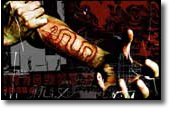AreaXbox Fahrenheit - interview
Deutsch English
AreaXbox: Can you give us a short introduction of yourself?
David Cage: My name is David Cage. I am 34 years old and I have a 4 years old little boy. I am CEO and founder of Quantic Dream. I am also writter/director of Nomad Soul and Fahrenheit. I worked for ten years in the music industry before writing my first game (Nomad Soul) and founding Quantic Dream in 1997.
My initial motivation was to use this wonderful new medium called real time 3D to create new kind of experiences and experiment new possibilities. Today, Quantic Dream is one of the leading french developers with a permanent team of 50 people, a 24 optical cameras Motion Capture set and an in-house digital sound studio.
AXB: After the very ambitious Omikron – The Nomad Soul Quantic Dream brings (hopefully this year) its next game, Fahrenheit, on the market. Can you give us a description of the games’ content?
DC: Fahrenheit aims to create an experience where the player is the hero of a movie, where his choices can really change the course of the story. A lot of work was done on the quality of the storytelling, acting and directing to create an experience comparable to a movie, but with real interactivity.
For Fahrenheit, we have developed a new concept of storytelling (we call "Bending Stories"), we have created a new approach to interfaces and new kind of tools for interactive cinema.
Among the key features : Multi-character control, Multi-Window display (like seen in "24"), physical analogue control of the actions, "Hollywood type" action sequences with stuntmen, all animations in optical Motion Capture and more…
AXB: Omikron was some kind of Beat’em Up-Shooter-Adventure-mixture. If you had to categorize Fahrenheit, which genre would best describe the gameplay? Is the focus more on the adventure side or on the action side?
DC: In short, Fahrenheit tries to reinvent the "adventure" genre and to figure out how we can change it from a slow-paced-often-boring genre to an exciting and compelling experience. It is an exciting challenge as it is a very open field. It seems that very few people are really looking in this direction. More people know how to make a good shooting game than how to tell a good interactive story.
With Fahrenheit, I have tried to merge story and action in a different way. The game is definitely story based, but we tried to keep it fast-paced with very compelling action sequences. What I like about these sequences is that each one is different. Unlike most games where all actions sequences are identical, in Fahrenheit, the player will have to face different situations in each scene. We have some car chases, boxing, ice skating, basketball playing or Matrix-like fights on the top of a building. We try to surprise the player in each scene to be sure he never knows what to expect next.
AXB: Like in Omikron, the player of Fahrenheit will have the opportunity to switch the protagonist during the game. What difference in concept can we aspect compared to Nomad Soul?
DC: I continue to explore the schizophrenic possibilities; this is an aspect that is really intriguing to me. I play with it in a different way in Fahrenheit and in Nomad Soul. In Fahrenheit, you can play the different protagonists of the story and use them to make the story progress. You don't have access to any character but rather to a pool of main or secondary characters that play an important role in the plot.
We tried to make this aspect very compelling and really put the player in the shoes of his character. It really opens new possibilities and I believe it creates a different kind of experience.
AXB: Fahrenheit will feature a new, analogue control schema. What were your reasons to choose this new kind of control mechanism?
DC: I was looking for a way to create a strong identification between the player and his character. The most interesting way I could find was to create a physical parallel between the actions the character and the player have to do. The right analogue stick was the most obvious choice. It allows to really "unfold" the animations and to increase the immersion. We call this system "MPAR" (for "Motion Physical Action Reaction" –we love acronyms…).
AXB: Don`t you think, that such controls might overwhelm inexperienced players like seen in Dreamworks Trespasser (PC)?
DC: The MPAR system is really intuitive. It takes the good side of inverse cinematic without the bad side. We believe it will make Fahrenheit really appealing and accessible to new gamers and experienced gamers.
AXB: After the first pictures and previews it became surprisingly silent around Fahrenheit. After more than a year radio silence many players believed the game got cancelled. What were the reasons for this long delay?
DC: At Quantic Dream, we are used to communicate about our projects at a very early stage. We tried to talk about Fahrenheit when it was just a concept and we were really surprised by the overwhelming feedback we received from gamers and press. It took us some time to negotiate with publishers and sign a deal for Fahrenheit. We put the production on hold during this time.
AXB: Is there anything else you want to tell our readers?
DC: I really think that Fahrenheit will be different from other games. I hope it will show that it is possible to make video games differently.
Some journalists wrote that Nomad Soul prefigured what video games would be in the future. I hope that Fahrenheit will be a significant step in this direction...
AXB: Thank you for your time.
Source: Area XboX
Previous News
- Area Xbox Interview: Fahrenheit
- IMMORTEL – Ad VITAM
- THE GAMES MACHINE: Fahrenheit Preview Italian
- Fahrenheit now also announced for 3G mobile phones
- Location design pour un projet de jeu vidéo réalis...
- Atari Acquires Rights To 'Fahrenheit' Video Game
- VIDEO GAMES : 23 FRENCH PROJECTS SUPPORTED BY THE ...
- Back on track
- Exodus: Myth or Reality?
- Exodus: Mythe ou réalité?


 Saturday, March 27, 2004
Saturday, March 27, 2004